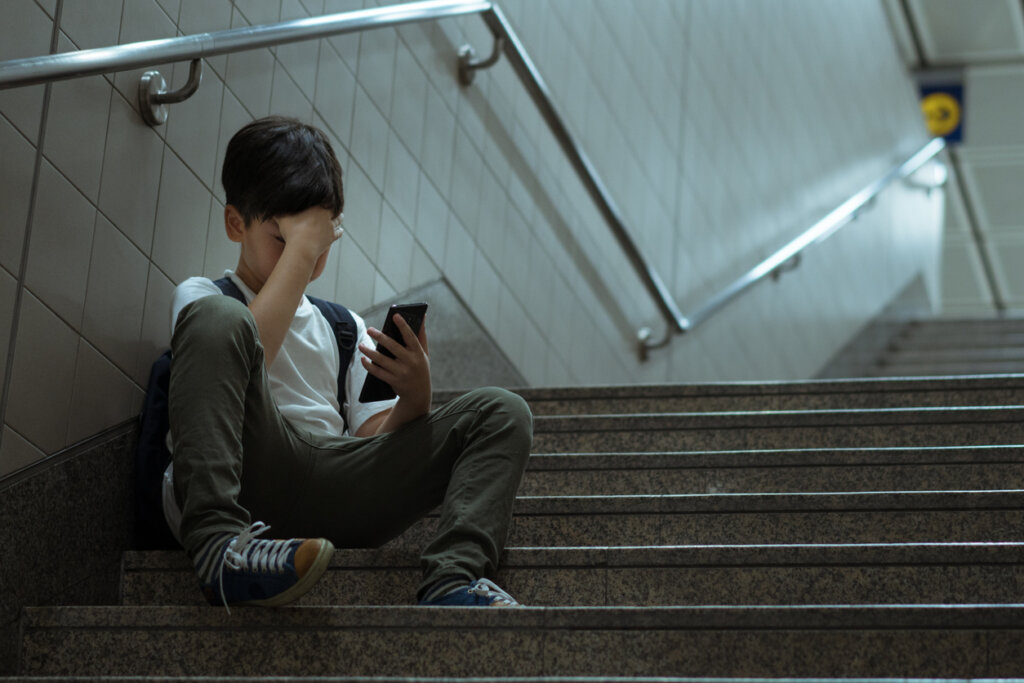The Prevention of Cyberbullying in School


Written and verified by the psychologist Gorka Jiménez Pajares
Did you ever felt persecuted at school? Unfortunately, bullying has always existed. However, today, it breaks through walls that previously acted as protection. Today, WhatsApp, Instagram, TikTok, and other social media are frequently used by abusers to make their malicious acts visible. In fact, bullying and cyberbullying have the potential to create wounds that become burned into the brains of children.
Firstly, let’s reflect on the definition of bullying. It’s the set of behaviors that involve the persecution, both physical and verbal, as well as psychological, of a student. These aggressions occur from one individual or group to another individual chosen to be the victim of repeated attacks.
“In the last two decades, we have witnessed a greater awareness and social awareness of school conflict.”
-Lucas-Molina-

Cyberbullying in the classroom
Harassment encompasses a set of intentional and negative actions that place the harassed in the position of a victim. There are three components to bullying: the intention in the aggression, the repetitive nature of the action, and the imbalance of power between the bully and the bullied.
Cyberbullying is a subtype of bullying. The aggression occurs on cell phones and social media. Consequently, its scope is greater because the aggression is visible to more people. Moreover, the victim is unable to escape from the situation in which they’re being harassed, humiliated, and intimidated. Frequently, the offender hides behind the anonymity the Internet provides them and becomes invisible. In fact, harassment on social media can even become permanent.
Research indicates that students would feel less inclined to bully in this way in less permissive contexts. At the same time, higher levels of bullying have been observed in classes with larger numbers of students. On the contrary, lower levels of bullying have been seen in classes where students feel supported and have a good relationship with their teachers.
“Centers with safe, positive, and warm climates, which have clear and shared rules against bullying, are protective factors against cyberbullying.”
-Morin-
Recommendations for its prevention
Research claims that around 90 percent of victims suffer bullying in its two modalities: the traditional face-to-face kind as well as cyberbullying. For this reason, experts have proposed that the best approach is to promote its prevention. Therefore, victims should be educated on safer use of the Internet as well as aspects related to digital citizenship.
Fonseca (2021) proposed some recommendations for the prevention of bullying. They’re as follows:
1. Adopting a comprehensive approach (whole-school-approach) is key
Initiatives involving the entire educational community have been found to be more likely to reduce cyberbullying. In addition to intervening in the classroom, it’s important to provide prevention education for teachers, families, and other center workers.
“The commitment and involvement of the school in the prevention of bullying and cyberbullying are important factors that contribute to its reduction and for this, the support of the relevant public administrations is essential.”
-Sainio-
2. Start from elementary school
The sooner prevention begins, the better. Moreover, it’s necessary to take into account the evolutionary characteristics of the students. For example, the role played by the peer group or the role of family members according to age.
Research suggests that the effectiveness of prevention programs decreases as students get older. This is one of the reasons why there tends to be a rise in cases in secondary education students.
Prevention means stopping the problem before it occurs. When we implement cyberbullying prevention programs in secondary education, we’re not preventing, but intervening. The goal must be to eradicate bullying.
3. Gender perspective
According to experts, prevention measures should take gender into account. It seems that boys often play the bullying role and girls tend to suffer more from cyberbullying.
Consequently, there are gender differences in bullying. However, they’re not linked to socialization or the behavioral expectations associated with boys and girls. They’re related to the fact that boys, in their natural process of socialization, use aggression to exercise power in relationships within their peer group.
“The greater empathy observed in girls could play a protective role, while the greater risk-taking by boys upon reaching puberty could be a risk factor.”
-Lucas-Molina-

4. Strengthen the bond between students and the school
Bullying frequently involves groups. In fact, around 90 percent of bullying situations usually occur among peers from the same group. Therefore, it’s essential to promote positive relationships among peers through participatory activities.
One possible activity is cooperative work. It improves aspects of the student-student and student-teacher relationships. However, before promoting a safe, warm, and positive climate in the classroom, it’s extremely important that the students feel satisfied with their school. The feeling of belonging to the institution is a relevant factor here.
“There can be no school coexistence without real educational inclusion.”
-Llorent-
All cited sources were thoroughly reviewed by our team to ensure their quality, reliability, currency, and validity. The bibliography of this article was considered reliable and of academic or scientific accuracy.
-
Pedrero, F. E. (2021). Manual de Tratamientos Psicológicos. Infancia y Adolescencia. Pirámide.
-
Rivadulla López, J. C., & Rodríguez Correa, M. (2019). Ciberacoso escolar: experiencias y propuestas de jóvenes universitarios. RIED. Revista iberoamericana de educación a distancia.
-
Ramírez, F. C., & Hernández, F. J. R. (2017). Medidas relativas al acoso escolar y ciberacoso en la normativa autonómica española. Un estudio comparativo. Revista Electrónica Interuniversitaria de Formación del Profesorado, 20(1), 113-126.
This text is provided for informational purposes only and does not replace consultation with a professional. If in doubt, consult your specialist.








